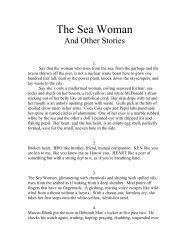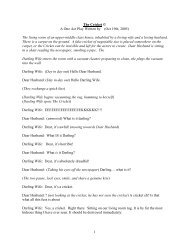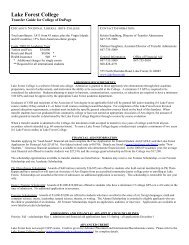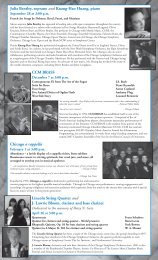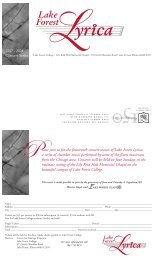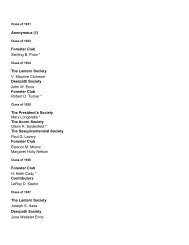Isabella d'Este: Woman in Charge - Lake Forest College
Isabella d'Este: Woman in Charge - Lake Forest College
Isabella d'Este: Woman in Charge - Lake Forest College
You also want an ePaper? Increase the reach of your titles
YUMPU automatically turns print PDFs into web optimized ePapers that Google loves.
<strong>Isabella</strong> d’Este:<br />
<strong>Woman</strong> <strong>in</strong> <strong>Charge</strong><br />
Kathryn Duncan<br />
FIYS 172<br />
Professor Roberts<br />
November 20, 2007
<strong>Isabella</strong><br />
Marchesa <strong>Isabella</strong> d’Este, arguably the most studied woman patron of her time,<br />
lived among the masters of European art. Dur<strong>in</strong>g this period she collected not only pieces<br />
from her contemporaries, but also antiques from the period that <strong>in</strong>spired the Renaissance<br />
movement. This paper will explore how through <strong>Isabella</strong>’s upbr<strong>in</strong>g<strong>in</strong>g and how she<br />
represented herself, she was not only able to ga<strong>in</strong> power <strong>in</strong> spheres that women were<br />
usually cut off from, but she surpassed both male family members and other women <strong>in</strong><br />
the field of art patronage.<br />
<strong>Isabella</strong>, born <strong>in</strong> 1474, lived a more privileged life than most other women of the<br />
Renaissance. She was the eldest child of Duke Ercole I d’Este and Leonora of Aragon.<br />
As a duke’s daughter, she received an education <strong>in</strong> Ferrara among the great humanist<br />
scholars, such as Battista Guar<strong>in</strong>o and Mario Equicola. 1 Although other women of her<br />
class were educated under their brothers’ tutors, <strong>Isabella</strong> was already impress<strong>in</strong>g her<br />
parents’ friends by age six with her “rare good sense and quickness.” 2 Her father largely<br />
<strong>in</strong>spired her later patronage because of his own <strong>in</strong>volvement <strong>in</strong> art. Accord<strong>in</strong>g to Clifford<br />
M. Brown, “<strong>Isabella</strong> saw her own father as her ma<strong>in</strong> competitor,” suggest<strong>in</strong>g that he was<br />
the one who taught her about antiquities. 3 He was quite attracted to power, and he<br />
showed this off through his public image. Not only did he plan the decorations <strong>in</strong> his<br />
apartments, the Palazzo di Belriguardo and the Palazzo dei Diamanti, but he also<br />
commissioned portraits <strong>in</strong> the forms of medals, busts, and pa<strong>in</strong>t<strong>in</strong>gs. 4 Like him, <strong>Isabella</strong><br />
later focused on the decorations of her private rooms. However, while <strong>Isabella</strong><br />
commissioned many mythological art pieces, her father was “a pious man…[and]<br />
encourage[d] the illum<strong>in</strong>ation of devotional books and <strong>in</strong>itiated a vast amount of church<br />
build<strong>in</strong>g and redecoration.” 5 Though <strong>Isabella</strong> bought a few religious pa<strong>in</strong>t<strong>in</strong>gs <strong>in</strong> her<br />
2
<strong>Isabella</strong><br />
lifetime, she didn’t <strong>in</strong>herit her father’s <strong>in</strong>tense religiousness and go so far as to decorate<br />
or build a church. <strong>Isabella</strong>’s mother also played a part <strong>in</strong> <strong>Isabella</strong>’s decorations of her<br />
apartments s<strong>in</strong>ce Leonora occupied similarly ornamented rooms. 6 Her “walls were<br />
covered with pa<strong>in</strong>t<strong>in</strong>gs by the best Flemish and Italian masters,” which <strong>Isabella</strong> would<br />
have seen frequently and probably admired as a curious young child. 7 <strong>Isabella</strong> displays<br />
characteristics from both her parents <strong>in</strong> her later art patronage, but mostly takes after her<br />
mother’s fondness of European masters around her home.<br />
<strong>Isabella</strong>’s marriage to Francesco II Gonzaga at the age of 16 also helped her to<br />
become such a powerful patron. Be<strong>in</strong>g of the upper class, <strong>Isabella</strong> spent much of her time<br />
socializ<strong>in</strong>g and mak<strong>in</strong>g connections <strong>in</strong> order to promote the Este and Gonzaga name.<br />
Although she faced setbacks f<strong>in</strong>ancially, often her personal ties helped her to obta<strong>in</strong> art.<br />
She was especially skilled at “call<strong>in</strong>g upon the generosity of others so that she could<br />
make acquisitions without empty<strong>in</strong>g her purse.” 8 For example, when the French<br />
ransacked Lodovico Sforza’s home <strong>in</strong> 1499, she quickly wrote to one of the traitors,<br />
ask<strong>in</strong>g for a clavichord that had been <strong>in</strong> the house. 9 <strong>Isabella</strong> also knew how to charm her<br />
peers so that they would later pay her favors. She frequently sent portraits of herself as<br />
presents, such as to Equicola’s mistress “<strong>in</strong> turn for the pa<strong>in</strong>s which this beloved friend<br />
had taken with her birthday present.” 10 Although her <strong>in</strong>come of 8000 to 9000 ducats a<br />
year and her allowance from her father was more than enough for the average woman,<br />
<strong>Isabella</strong> often found herself short of money because of her husband’s military needs or<br />
her avid collect<strong>in</strong>g. 11 Impressive for the time period and her status as a woman, <strong>Isabella</strong><br />
was able to escape debt because of her prudence and ability to negotiate prices. Not only<br />
was <strong>Isabella</strong> skilled at manag<strong>in</strong>g money, she often was “left to hold the re<strong>in</strong>s of the state”<br />
3
<strong>Isabella</strong><br />
while her husband was away for military affairs. 12 Many women of the time couldn’t<br />
leave their homes, much less be <strong>in</strong> charge of a city.<br />
While <strong>Isabella</strong> dabbled <strong>in</strong> many types of patronage, she’s most famous for the<br />
pa<strong>in</strong>t<strong>in</strong>gs that adorned her studiolo and Grotta, located <strong>in</strong> the Castello di San Giorgio.<br />
<strong>Isabella</strong> lived <strong>in</strong> different spaces dur<strong>in</strong>g her adulthood, but the majority of it was spent <strong>in</strong><br />
the Castello with her husband. However, after his death, she moved to the Palazzo<br />
Ducale and brought her pa<strong>in</strong>t<strong>in</strong>gs with her. While the studiolo <strong>in</strong>cluded only n<strong>in</strong>e<br />
pa<strong>in</strong>t<strong>in</strong>gs all specifically commissioned by <strong>Isabella</strong>, her Grotta was a collection room,<br />
<strong>in</strong>clud<strong>in</strong>g antiquities and contemporary literature, portraits, statues, and other varieties of<br />
art. These rooms were her sanctuaries, and <strong>Isabella</strong> dreamed that “the walls should be<br />
adorned with pa<strong>in</strong>t<strong>in</strong>gs giv<strong>in</strong>g expression to her ideals of culture and dispos<strong>in</strong>g the m<strong>in</strong>d<br />
to pure and noble thoughts.” 13 This shows the importance of these rooms to <strong>Isabella</strong> – not<br />
only were they a place to enterta<strong>in</strong> her <strong>in</strong>timates, they also served as a place to escape<br />
from the outside world that often butted heads with this strong woman.<br />
It was by “no means the norm of the age that a woman of <strong>Isabella</strong> d’Este’s rank<br />
and education required a studiolo and a Grotta.” 14 This is especially unusual when we<br />
consider that <strong>Isabella</strong> “lived among the foxes and the wolves of the Renaissance.” 15<br />
<strong>Isabella</strong> was able to thrive despite the popular views that women should not be allowed <strong>in</strong><br />
the public sphere because she grew up learn<strong>in</strong>g to be as clever and persuasive as the men<br />
<strong>in</strong> her social class. Her husband was also enamored of her from the day they met, and<br />
because of this he was probably more easily persuaded to allow her <strong>in</strong>fluence to extend<br />
outside of their home. 16<br />
4
<strong>Isabella</strong><br />
The architectural decorations of these spaces were filled with Gonzaga symbols,<br />
such as the symbol of w<strong>in</strong>gs attached to a r<strong>in</strong>g <strong>in</strong> the center of the blue ceil<strong>in</strong>g of the<br />
studiolo. 17 This promoted her own power through her family and social ties. The walls of<br />
her Grotta were decorated with engraved musical notes, represent<strong>in</strong>g her love for music<br />
of course, and the floors were pa<strong>in</strong>ted with a symbolic “blaz<strong>in</strong>g sun, with fiery rays<br />
shoot<strong>in</strong>g from it” along with Lat<strong>in</strong> words express<strong>in</strong>g <strong>Isabella</strong>’s desire for everyth<strong>in</strong>g. 18<br />
Equiola expressed that the Grotta was “filled with every k<strong>in</strong>d of delight,” show<strong>in</strong>g that<br />
even scholarly men of the time respected <strong>Isabella</strong>’s art collect<strong>in</strong>g and decorations. 19<br />
Much more impressive than the motifs <strong>in</strong> her apartments, however, were the<br />
seven mythological pa<strong>in</strong>t<strong>in</strong>gs that hung <strong>in</strong> the studiolo. These pieces by Andrea<br />
Mantegna, Lorenzo Costa, Pietro Perug<strong>in</strong>o, and Antonio da Correggio that she<br />
commissioned were not orig<strong>in</strong>ally meant to be a cycle, but as she collected them, they<br />
became just that – a story of chastity versus pleasure.<br />
This idea could have been very much <strong>in</strong>spired by <strong>Isabella</strong>’s personal life with her<br />
husband, who, just a few years <strong>in</strong>to his marriage, met “a certa<strong>in</strong> Theodora, who became<br />
his mistress, and by whom he had two daughters.” 20 These events quite possibly<br />
motivated <strong>Isabella</strong> to commission these allegories for her room, which early on was<br />
“<strong>in</strong>tended to display…portraits of friends and loved ones.” 21 In Costa’s Coronation of a<br />
Lady, <strong>Isabella</strong> is be<strong>in</strong>g crowned with a garland by Cupid while surrounded by poets and<br />
musicians that are actually portraits of her friends (no doubt to flatter them). Accord<strong>in</strong>g to<br />
Egon Verheyen, <strong>Isabella</strong>’s crown<strong>in</strong>g is a reward and representations of the Virg<strong>in</strong> Mary<br />
are set <strong>in</strong> the background. 22 This tie to the Madonna shows that <strong>Isabella</strong>’s reward is for<br />
her chastity and her companions that saw this piece surely recognized this connection.<br />
5
<strong>Isabella</strong><br />
The other pieces <strong>in</strong> the room, especially Mantegna’s M<strong>in</strong>erva and Perug<strong>in</strong>o’s<br />
Battle Between Chastity and Love, which <strong>Isabella</strong> worked so hard to obta<strong>in</strong>, strengthen<br />
this tie. M<strong>in</strong>erva depicts M<strong>in</strong>erva as a representation of wisdom try<strong>in</strong>g to ward off the<br />
vices, <strong>in</strong>clud<strong>in</strong>g an especially sensual Venus, <strong>in</strong> order to free the Mother of Virtue.<br />
Perug<strong>in</strong>o’s work shows a battle scene of Diana (the goddess of chastity) and M<strong>in</strong>erva<br />
outright fight<strong>in</strong>g Venus and Cupid. Both of these show that <strong>in</strong> <strong>Isabella</strong>’s world, chastity<br />
was the most admired virtue while earthly love was to be condemned by all th<strong>in</strong>gs good.<br />
However, at first this theme seems to actually re<strong>in</strong>force the <strong>in</strong>feriority of women s<strong>in</strong>ce it<br />
agreed with prevalent ideas that impure women should be looked down upon. But, as<br />
mentioned previously, <strong>Isabella</strong> had to conform to these biased views of the Renaissance<br />
<strong>in</strong> order to get ahead. While she probably actually looked down upon the fact that her<br />
whole person could be judged by her purity, while her husband’s fl<strong>in</strong>gs went<br />
unmentioned, she could ga<strong>in</strong> more power <strong>in</strong> the eyes of her contemporaries by<br />
represent<strong>in</strong>g herself as chaste.<br />
<strong>Isabella</strong> was also very strict about the <strong>in</strong>structions that she provided artists for her<br />
commissions. When “she heard Perug<strong>in</strong>o had represented Venus as a nude figure,” she<br />
quickly wrote a letter that the whole mean<strong>in</strong>g of the fable would be ru<strong>in</strong>ed and that it had<br />
to be changed at once. 23 This <strong>in</strong>sistence on hav<strong>in</strong>g Venus be clothed also shows<br />
<strong>Isabella</strong>’s personal objection to the images of women that were nude <strong>in</strong> order to please<br />
the viewer as was true with many of her son’s commissions. Dur<strong>in</strong>g the Renaissance,<br />
men “pa<strong>in</strong>ted a naked woman because [they] enjoyed look<strong>in</strong>g at her,” but <strong>Isabella</strong>, be<strong>in</strong>g<br />
a woman role model, surely wanted her nudes to have mean<strong>in</strong>g beh<strong>in</strong>d them rather than<br />
to be naked for the viewers’ pleasure. 24<br />
6
<strong>Isabella</strong><br />
When compared with the art of her husband and her eldest son, Duke Federico II<br />
Gonzaga, these works of art clearly depict female power. Francesco and Federico<br />
commissioned many typical art pieces of the time. Though Francesco focused on the<br />
decoration of his apartments much as his wife did, and they shared a motif of Muses,<br />
most of the art <strong>in</strong> their rooms were complete opposites. While <strong>Isabella</strong> collected<br />
antiquities and her mythological series, Francesco’s art <strong>in</strong>cluded themes of “military<br />
conquest…consistent with Francesco’s self-promoted condottiere image,” portraits of<br />
himself and his sons that sent a “strong dynastic message,” pictures of “his beautiful<br />
horses and his beautiful dogs,” and maps of cities. 25 These images all send the message of<br />
a strong and powerful man, but unlike <strong>Isabella</strong>’s, his strength is shown through alliances<br />
and victories rather than personal traits. While <strong>Isabella</strong> sends a subtle message of her<br />
purity, Francesco shows himself as a symbol of strength <strong>in</strong> a very frank way. This<br />
comparison strengthens <strong>Isabella</strong>’s uniqueness <strong>in</strong> the art world and because of this, art<br />
historians have frequently ignored her husband. 26 Also, <strong>Isabella</strong> had an “unquenchable<br />
desire for antiquities” while her husband showed no <strong>in</strong>terest <strong>in</strong> this type of collection,<br />
although it was an activity more readily associated with the male gender. 27 The fact that<br />
Francesco “followed the example of [<strong>Isabella</strong>’s] room,” and that it was not the other way<br />
around shows of the <strong>in</strong>fluence that <strong>Isabella</strong> had <strong>in</strong> her time. 28<br />
While she commissioned the Triumph of Virtue and the Triumph of Vice by<br />
Correggio, reflect<strong>in</strong>g the same theme as the other scenes <strong>in</strong> her studiolo, her husband<br />
commissioned the Triumphs of Caesar, a series by Mantegna that shows the victorious<br />
Julius Caesar return<strong>in</strong>g from his military engagements. Through just this comparison of<br />
Triumph pa<strong>in</strong>t<strong>in</strong>gs we can see what was important to each of these patrons and how their<br />
7
<strong>Isabella</strong><br />
gender roles were re<strong>in</strong>forced through these depictions that adorned their private spaces.<br />
<strong>Isabella</strong>’s two pieces are almost mythological group portraits, Triumph of Virtue show<strong>in</strong>g<br />
clothed angels and women happily set aga<strong>in</strong>st a calm<strong>in</strong>g seaside landscape and Triumph<br />
of Vice depict<strong>in</strong>g women seductively teas<strong>in</strong>g a male god <strong>in</strong> the center <strong>in</strong> a forest clear<strong>in</strong>g.<br />
On the other hand, Francesco’s commissioned cycle is made up of bright colors like gold<br />
to make a statement of his wealth even more obvious by us<strong>in</strong>g such a f<strong>in</strong>e color.<br />
<strong>Isabella</strong>’s son, Federico, also commissioned mythological images like the ones of<br />
his mother’s that he grew up with, but his were clearly created by a man while hers<br />
celebrate women like M<strong>in</strong>erva, Mary, and heavenly Venus. Federico’s most contrast<strong>in</strong>g<br />
commission was a series of four pa<strong>in</strong>t<strong>in</strong>gs by Correggio titled The Loves of Jupiter. The<br />
women <strong>in</strong> these images, Danäe, Io, and Leda, are all nudes enraptured by forms meant to<br />
portray Jupiter. These images are more like the typical Renaissance mythological scenes,<br />
produced for the viewers’ pleasure and sexuality. These women are almost celebrated for<br />
be<strong>in</strong>g overtly sexual while the ones <strong>in</strong> <strong>Isabella</strong>’s commissions are shunned. However, <strong>in</strong><br />
reality, the outcome <strong>in</strong> <strong>Isabella</strong>’s pieces was much more likely. This difference <strong>in</strong><br />
preferences can be attributed to the patrons’ personal lives as well as their gender. While<br />
the Marchesa was hurt by affairs, her son took pleasure <strong>in</strong> one with <strong>Isabella</strong> Boschetti, of<br />
whom he even commissioned a portrait by Titian. 29 These mistresses could have affected<br />
both these viewpo<strong>in</strong>ts <strong>in</strong> art s<strong>in</strong>ce <strong>Isabella</strong> looked down on her husband’s mistress, and<br />
therefore his impurity, while Federico flaunted his mistress and would want rem<strong>in</strong>ders of<br />
her and her sensuality throughout his house.<br />
Federico also redid his father’s former apartments <strong>in</strong> the Castello, cover<strong>in</strong>g the<br />
walls with soldiers, men slay<strong>in</strong>g a dragon, and an antique city that reflected the art of<br />
8
<strong>Isabella</strong><br />
manly activities that his father had previously displayed <strong>in</strong> the space. 30 The ceil<strong>in</strong>g of<br />
Federico’s Camera dello Zodiaco features his own astrology chart with a representation<br />
of Hercules that is strik<strong>in</strong>gly similar to this duke <strong>in</strong> the middle. This room suggests that<br />
he was try<strong>in</strong>g to show off his power by symboliz<strong>in</strong>g that “at the moment of Federico II<br />
Gonzaga’s birth, the heavens [had] proclaimed that he had been born to rule.” 31<br />
This type of authority is much different than the one that <strong>Isabella</strong> depicted. While<br />
she is <strong>in</strong> control of her self and her body, Federico tries to assert control over all of<br />
Mantua with this image. In Venus and Cupid with a Satyr, paid for by Federico, and Mars<br />
and Venus commissioned by <strong>Isabella</strong> and pa<strong>in</strong>ted by Mantegna, the portrayals of the<br />
goddess of love are drastically different. In Correggio’s piece, there are only the three<br />
completely nude figures, which allows for much more detail <strong>in</strong> their bodies, whereas<br />
Mars and Venus depicts over a dozen people, most of which are clothed. And while<br />
Federico’s Venus is recl<strong>in</strong><strong>in</strong>g <strong>in</strong> a pose that could attract the viewer and also shows her<br />
bodily weakness for the satyr, our other Venus stands up straight and proud of her true<br />
love for Mars. This further shows the difference between the sensuality that Federico<br />
chose to pay for and the images of love that his mother ordered.<br />
Not only can we see <strong>Isabella</strong>’s remarkable amount of power when we compare<br />
her to her male family members, it’s even more evident compared to other Italian women<br />
of the time. In Rosi Gilday’s article about the women patrons of Neri di Bicci, who was<br />
one of the few artists that kept extensive records of his commissions, there are only 10<br />
women patrons out of 152 total commissions that the artist received. Also, while the<br />
men’s commissioned works are for a variety of purposes, all of the women’s are for<br />
religious sett<strong>in</strong>gs. 32 One can see just how different <strong>Isabella</strong> was from other woman<br />
9
<strong>Isabella</strong> 10<br />
patrons through these numbers. Most women were conf<strong>in</strong>ed to three types of art they<br />
could commission: “commemorative structures such as tombs or family chapels; religious<br />
complexes such as temples, churches, convents, monasteries, and novitiates; build<strong>in</strong>gs<br />
related to the social good or social welfare such as aqueducts, hospitals, orphanages, and<br />
schools.” 33 Unlike these women, <strong>Isabella</strong> was allowed to go outside of her social<br />
boundaries and aga<strong>in</strong>st the idea that women “had no public persona,” and commission<br />
themes that she drew from literary sources. 34 All ten of these women only paid for one<br />
piece of art while <strong>Isabella</strong> bought hundreds of books, <strong>in</strong>struments, statues, and pa<strong>in</strong>t<strong>in</strong>gs.<br />
Some of the mentioned women were of the patrician class and would have had money<br />
comparable to <strong>Isabella</strong>’s, yet her love for art and relative freedom <strong>in</strong> spend<strong>in</strong>g her money<br />
caused her to make purchases beyond what other women did. Another aspect that is<br />
unique to the Marchesa is that she wrote letters and ordered art by herself, while all of<br />
Neri’s patrons had males that assisted them <strong>in</strong> order<strong>in</strong>g works.<br />
Another way <strong>Isabella</strong> ga<strong>in</strong>ed power was through her portraits and depictions of<br />
herself. These portraits were given to others as gifts as already mentioned, and she also<br />
was depicted <strong>in</strong> Coronation of a Lady. But other than these, she had several portraits<br />
commissioned for herself, such as one by Leonardo da V<strong>in</strong>ci that was never completed<br />
although the draw<strong>in</strong>g is <strong>in</strong> the Louvre today. 35 This portrait, like others of women at the<br />
time, is <strong>in</strong> profile view, which is surpris<strong>in</strong>gly passive for this patron, but through<br />
Leonardo’s skills it still shows off the Marchesa’s lively personality <strong>in</strong> her eyes. Her later<br />
portraits by Titian, which she had more control over, are more serious and feature<br />
<strong>Isabella</strong> as a stern woman look<strong>in</strong>g right at the viewer while dressed <strong>in</strong> a variety of<br />
luxuries available. In the first image she takes up the entire picture with her f<strong>in</strong>e red
<strong>Isabella</strong> 11<br />
dress, show<strong>in</strong>g that she can be as large and menac<strong>in</strong>g as any man could be. In the second,<br />
she looks even younger than the first and has more delicate, fem<strong>in</strong><strong>in</strong>e qualities <strong>in</strong> her<br />
dress and body. The fact that she is fac<strong>in</strong>g frontward <strong>in</strong> two of her portraits was identified<br />
with power <strong>in</strong> the time period because it is a much more active stance than a profile view.<br />
She is also alone <strong>in</strong> these images, emphasiz<strong>in</strong>g her own power rather than that of her<br />
friends or relatives. <strong>Isabella</strong> is seen <strong>in</strong> these portraits without symbols or allusions,<br />
perhaps because she wanted the focus to be on her rather than the mean<strong>in</strong>g beh<strong>in</strong>d the<br />
picture. <strong>Isabella</strong>’s representation of herself <strong>in</strong> reality was also controlled and she often<br />
ordered new clothes and jewels for occasions such as festivals. In fact, at Lucrezia<br />
Borgia’s wedd<strong>in</strong>g the Marchesa wore “a black velvet robe trimmed with lynx fur, with a<br />
green velvet vest studded over with gold plaques.” Guests hailed her as the most beautiful<br />
woman at the wedd<strong>in</strong>g and one attendee went so far as to say “that if the bride had<br />
foreseen this, she would have made her entry by torchlight!” 36<br />
In conclusion, <strong>Isabella</strong>’s common sense and ability to ma<strong>in</strong>ta<strong>in</strong> her place <strong>in</strong> a<br />
society that centered around politics are what led to her be<strong>in</strong>g seen as “the noblest and<br />
most perfect type of the Italian women of the Renaissance.” 37 She was able to get her<br />
way us<strong>in</strong>g her charm and connections to <strong>in</strong>fluence even the most powerful men. Not only<br />
did these assets help her succeed <strong>in</strong> the private sphere of her home, they helped her to<br />
amass her impressive collection of art and communicate effectively with artists.<br />
1<br />
Gordon Marshall Beamish, “Ercole I d’Este,” <strong>in</strong> The Dictionary of Art, ed. Jane Turner<br />
(New York: Grove, 1996), 520.<br />
2 rd<br />
Julia Cartwright, <strong>Isabella</strong> d’Este, vol. 1, 3 ed. (New York: E.P. Dutton and Company,<br />
1905), 4.
<strong>Isabella</strong> 12<br />
3<br />
Clifford M. Brown, “A Ferrarese Lady and a Mantuan Marchesa,” <strong>in</strong> Women and Art <strong>in</strong><br />
Early Modern Europe: Patrons, Collectors, and Connoisseurs, ed. Cynthia Lawrence<br />
(University Park, PA: The Pennsylvania State University Press, 1997), 64.<br />
4<br />
Clifford M. Brown, “<strong>Isabella</strong> d’Este,” <strong>in</strong> The Dictionary of Art, ed. Jane Turner (New<br />
York: Grove, 1996), 520.<br />
5<br />
Beamish, “Ercole,” 520.<br />
6<br />
Molly Bourne, “Renaissance Husbands and Wives as Patrons of Art: The Camer<strong>in</strong>i of<br />
<strong>Isabella</strong> d’Este and Francesco II Gonzaga,” <strong>in</strong> Beyond <strong>Isabella</strong>: Secular Women Patrons<br />
of Art <strong>in</strong> Renaissance Italy, ed. Sheryl E. Reiss and David G. Wilk<strong>in</strong>s (Kirksville, MO:<br />
Truman State University Press, 2001), 96.<br />
7<br />
Cartwright, <strong>Isabella</strong>, vol. 1, 12.<br />
8 Brown, “Ferrarese Lady,” 70.<br />
9 Cartwright, <strong>Isabella</strong>, vol. 1, 153.<br />
10<br />
Ibid., 282.<br />
11<br />
Ibid., 226.<br />
12<br />
Ibid., 250.<br />
13<br />
Ibid., 160.<br />
14<br />
Brown, “Ferrarese Lady,” 63.<br />
15<br />
Robert de la Sizeranne, “<strong>Isabella</strong> d’Este and her Allegories <strong>in</strong> the Louvre,” <strong>in</strong><br />
Celebrities of the Italian Renaissance, trans. Jeffery E. Jeffery (New York: Brentano’s,<br />
1926), 155.<br />
16<br />
Cartwright, <strong>Isabella</strong>, vol. 1, 6.<br />
17<br />
Egon Verheyen, The Pa<strong>in</strong>t<strong>in</strong>gs <strong>in</strong> the Studiolo of <strong>Isabella</strong> d’Este at Mantua (New<br />
York: New York University Press, 1971), 12.<br />
18<br />
Sizeranne, “Allegories,” 182.<br />
19<br />
S. Kolsky, “An Unnoticed Description of <strong>Isabella</strong> d’Este’s Grotta,” Journal of the<br />
Warburg and Courtauld Institutes 52 (1989): 234.<br />
20<br />
Sizeranne, “Allegories,” 159.<br />
21<br />
Verheyen, Studiolo, 10.<br />
22<br />
Ibid., 45.<br />
23<br />
Cartwright, <strong>Isabella</strong>, vol. 1, 336.<br />
24<br />
John Berger, Ways of See<strong>in</strong>g, (London, Pengu<strong>in</strong> Books, 1972), 51.<br />
25<br />
Bourne, “Husbands and Wives,” 105-107.<br />
26<br />
Clifford M. Brown and Anna Maria Lorenzoni, “’Concludo che non vidi mai la piu<br />
bella casa <strong>in</strong> Italia:’ The Frescoed Decorations <strong>in</strong> Francesco II Gonzaga's Suburban Villa<br />
<strong>in</strong> the Mantuan Countryside at Gonzaga (1491-1496),” Renaissance Quarterly 49, no. 2<br />
(1996): 268.<br />
27<br />
Brown, “Ferrarese Lady,” 55.<br />
28 Cartwright, <strong>Isabella</strong>, vol. 1, 289.<br />
29 Julia Cartwright, <strong>Isabella</strong> d’Este, vol. 2, 3 rd ed. (New York: E.P. Dutton and Company,<br />
1905), 227.<br />
30 Kristen Lipp<strong>in</strong>cott and Rodolfo Signor<strong>in</strong>i, “The Camera dello Zodiaco of Federico II<br />
Gonzaga,” Journal of the Warburg and Courtauld Institutes 54 (1991): 246.<br />
31 Ibid., 247.
<strong>Isabella</strong> 13<br />
32 Rosi Prieto Gilday, “The Women Patrons of Neri di Bicci,” <strong>in</strong> Beyond <strong>Isabella</strong>:<br />
Secular Women Patrons of Art <strong>in</strong> Renaissance Italy, ed. Sheryl E. Reiss and David G.<br />
Wilk<strong>in</strong>s (Kirksville, MO: Truman State University Press, 2001), 60.<br />
33 Carolyn Valone, “Matrons and Motives: Why Women Built <strong>in</strong> Early Modern Rome,”<br />
<strong>in</strong> Beyond <strong>Isabella</strong>: Secular Women Patrons of Art <strong>in</strong> Renaissance Italy, ed. Sheryl E.<br />
Reiss and David G. Wilk<strong>in</strong>s (Kirksville, MO: Truman State University Press, 2001), 318.<br />
34 Ibid., 317<br />
35 Sizeranne, “Allegories,” 145.<br />
36 Cartwright, <strong>Isabella</strong>, vol. 1, 202.<br />
37 Cartwright, <strong>Isabella</strong>, vol. 2, 391.
Bibliography<br />
<strong>Isabella</strong> 14<br />
Beamish, Gordon Marshall. "Ercole I <strong>d'Este</strong>." In The Dictionary of Art, edited by Jane<br />
Turner, 520. New York: Grove, 1996.<br />
Berger, John. Ways of See<strong>in</strong>g. London: Pengu<strong>in</strong> Books, 1972.<br />
Bourne, Molly. "Renaissance Husbands and Wives as Patrons of Art: The Camer<strong>in</strong>i of<br />
<strong>Isabella</strong> <strong>d'Este</strong> and Francesco II Gonzaga." In Beyond <strong>Isabella</strong>: Secular Women<br />
Patrons of Art <strong>in</strong> Renaissance Italy, edited by Sheryl E. Reiss and David G. Wilk<strong>in</strong>s,<br />
93-111. Kirksville, Mo: Truman State University Press, 2001.<br />
Brown, Clifford M., and Anna Maria Lorenzoni. "'Concludo Che Non Vidi Mai La Piu<br />
Bella Casa <strong>in</strong> Italia:" the Frescoed Decorations <strong>in</strong> Francesco II Gonzaga's Suburban<br />
Villa <strong>in</strong> the Mantuan Countryside at Gonzaga (1491-1496)." Renaissance Quarterly<br />
49, no. 2 (1996) .<br />
Brown, Clifford M. "A Ferrarese Lady and a Mantuan Marchesa." In Women and Art <strong>in</strong><br />
Early Modern Europe: Patrons, Collectors, and Connoisseurs, edited by Cynthia<br />
Lawrence, 53-71. University Park, PA: Pennsylvania State University Press, 1997.<br />
Cartwright, Julia. <strong>Isabella</strong> <strong>d'Este</strong>. 3rd ed. Vol. 1. New York: E.P. Dutton and Company,<br />
1905.
---. <strong>Isabella</strong> <strong>d'Este</strong>. 3rd ed. Vol. 2. New York: E.P. Dutton and Company, 1905.<br />
<strong>Isabella</strong> 15<br />
Gilday, Rosi Prieto. "The Women Patrons of Neri Di Bicci." In Beyond <strong>Isabella</strong>: Secular<br />
Women Patrons of Art <strong>in</strong> Renaissance Italy, edited by Sheryl E. Reiss and David G.<br />
Wilk<strong>in</strong>s, 51-66. Kirksville, Mo: Truman State University Press, 2001.<br />
Kolsky, S. "An Unnoticed Description of <strong>Isabella</strong> <strong>d'Este</strong>'s Grotta." Journal of the<br />
Warburg and Courtauld Institutes 52 (1989): 232--5.<br />
Lipp<strong>in</strong>cott, Kristen and Rodolfo Signor<strong>in</strong>i. "The Camera Dello Zodiaco of Federico II<br />
Gonzaga." Journal of the Warburg and Courtauld Institutes 54 (1991): 244-7.<br />
Sizeranne, Robert de la. "<strong>Isabella</strong> <strong>d'Este</strong> and Her Allegories <strong>in</strong> the Louvre." In Celebrities<br />
of the Italian Renaissance, 142-246. New York: Brentano's, 1926.<br />
Valone, Carolyn. "Matrons and Motives: Why Women Built <strong>in</strong> Early Modern Rome." In<br />
Beyond <strong>Isabella</strong>: Secular Women Patrons of Art <strong>in</strong> Renaissance Italy, edited by<br />
Sheryl E. Reiss and David G. Wilk<strong>in</strong>s, 317-330. Kirksville, Mo: Truman State<br />
University Press, 2001.<br />
Verheyen, Egon. The Pa<strong>in</strong>t<strong>in</strong>gs <strong>in</strong> the Studiolo of <strong>Isabella</strong> d’Este at Mantua. 23rd ed.<br />
New York: New York University Press for the <strong>College</strong> Art Association of America,<br />
1971.






